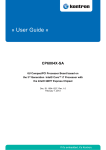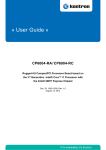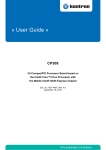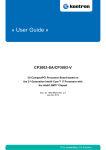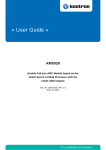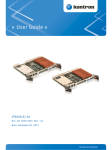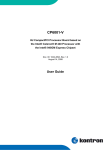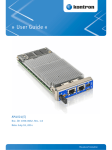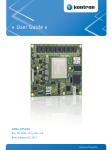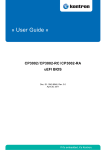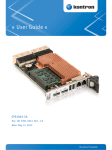Download CP3002 User Guide, Rev. 2.0 (INTRODUCTION)
Transcript
CP3002 3U CompactPCI Processor Board based on the Intel® Core™ i7 Processor with the Intel® QM57 Chipset Doc. ID: 1042-9252, Rev. 2.0 July 27, 2012 If it’s embedded, it’s Kontron. PRELIMINARY » User Guide « Preface CP3002 Revision History Publication Title: CP3002: 3U CompactPCI Processor Board based on the Intel® Core™ i7 Processor with the Intel® QM57 Chipset Doc. ID: 1042-9252 PRELIMINARY Rev. Brief Description of Changes Date of Issue 1.0 Initial issue 19-Jan-2011 2.0 General update, added description for the Intel® Core™ i7-660UE and the Intel® Celeron® U3405 processors. 27-Jul-2012 Imprint Kontron Modular Computers GmbH may be contacted via the following: MAILING ADDRESS TELEPHONE AND E-MAIL Kontron Europe GmbH +49 (0) 800-SALESKONTRON Sudetenstraße 7 [email protected] D - 87600 Kaufbeuren Germany For further information about other Kontron products, please visit our Internet web site: www.kontron.com. Disclaimer Copyright © 2012 Kontron AG. All rights reserved. All data is for information purposes only and not guaranteed for legal purposes. Information has been carefully checked and is believed to be accurate; however, no responsibility is assumed for inaccuracies. Kontron and the Kontron logo and all other trademarks or registered trademarks are the property of their respective owners and are recognized. Specifications are subject to change without notice. Page ii ID 1042-9252, Rev. 2.0 CP3002 Preface Revision History .........................................................................................................ii Imprint ........................................................................................................................ii Disclaimer ..................................................................................................................ii Table of Contents ...................................................................................................... iii List of Tables .............................................................................................................ix List of Figures ......................................................................................................... xiii Proprietary Note .......................................................................................................xv Trademarks ..............................................................................................................xv Environmental Protection Statement ........................................................................xv Explanation of Symbols .......................................................................................... xvi For Your Safety ...................................................................................................... xvii High Voltage Safety Instructions ........................................................................ xvii Special Handling and Unpacking Instructions ................................................... xvii General Instructions on Usage ............................................................................. xviii Two Year Warranty .................................................................................................. xix 1. Introduction ............................................................................. 1 - 3 1.1 Board Overview ....................................................................................... 1 - 3 1.2 Board-Specific Information ...................................................................... 1 - 4 1.3 System Expansion Capabilities ............................................................... 1 - 5 1.3.1 CP3002-HDD Module ..................................................................... 1 - 5 1.3.2 CP-RIO3-04 Rear I/O Module ......................................................... 1 - 5 1.3.3 Serial ATA Flash Module ................................................................ 1 - 5 1.4 Board Diagrams ...................................................................................... 1 - 5 1.4.1 Functional Block Diagram ............................................................... 1 - 6 1.4.2 Front Panel ..................................................................................... 1 - 7 1.4.3 Board Layout .................................................................................. 1 - 8 1.5 Technical Specification ............................................................................ 1 - 9 1.6 Standards .............................................................................................. 1 - 15 1.7 Related Publications ............................................................................. 1 - 18 2. Functional Description ........................................................... 2 - 3 2.1 Processor ................................................................................................ 2 - 3 ID 1042-9252, Rev. 2.0 Page iii PRELIMINARY Table of Contents Preface CP3002 2.2 Memory ....................................................................................................2 - 4 2.3 Intel® QM57 Express Chipset .................................................................2 - 5 2.4 Timer ........................................................................................................2 - 5 2.5 Watchdog Timer ......................................................................................2 - 6 2.6 Battery .....................................................................................................2 - 6 2.7 Reset .......................................................................................................2 - 6 2.8 Flash Memory ..........................................................................................2 - 6 2.8.1 SPI Boot Flash for uEFI BIOS .........................................................2 - 6 2.8.2 Serial ATA Flash Module (Optional) ................................................2 - 7 PRELIMINARY 2.9 8HP Expansion Module ...........................................................................2 - 7 2.10 Trusted Platform Module 1.2 (On Request) .............................................2 - 7 2.11 Board Interfaces ......................................................................................2 - 8 2.11.1 Front Panel LEDs ............................................................................2 - 8 2.11.1.1 Watchdog and Temperature Status LEDs ...............................2 - 8 2.11.1.2 General Purpose LEDs ...........................................................2 - 9 2.11.2 DIP Switch SW1 ............................................................................2 - 10 2.11.3 USB Interfaces .............................................................................. 2 - 11 2.11.3.1 Front Panel USB Connectors J9 and J10 ............................. 2 - 11 2.11.4 Integrated Graphics Controller ...................................................... 2 - 11 2.11.4.1 Graphics Memory Usage ......................................................2 - 12 2.11.4.2 VGA Analog Interface and Connector J6 ..............................2 - 12 2.11.5 Serial Ports ....................................................................................2 - 13 2.11.6 Gigabit Ethernet ............................................................................2 - 13 2.11.7 Serial ATA Interfaces .....................................................................2 - 15 2.11.7.1 Serial ATA Connector J3 .......................................................2 - 15 2.11.8 Debug Interface .............................................................................2 - 16 2.11.9 CompactPCI Interface ...................................................................2 - 16 2.11.9.1 Board Functionality when Installed in System Controller Slot 2 - 16 2.11.9.2 Board Functionality when Installed in Peripheral Slot ...........2 - 16 2.11.9.3 Front/Rear I/O Configuration ................................................2 - 16 2.11.9.4 Board Insertion/Replacement under Power .........................2 - 17 2.11.9.5 Power Ramping ....................................................................2 - 17 2.11.9.6 ENUM# Interrupt ...................................................................2 - 17 2.11.10 CompactPCI Connectors J1 and J2 ..............................................2 - 18 Page iv ID 1042-9252, Rev. 2.0 CP3002 Preface 2.11.10.1 CompactPCI Connector Keying ........................................... 2 - 18 2.11.10.2 CompactPCI Connectors J1 and J2 Pinouts ........................ 2 - 19 2.11.10.3 Optional Rear I/O Interface .................................................. 2 - 22 2.11.10.4 Rear I/O Pin Description ...................................................... 2 - 25 3. Installation ............................................................................... 3 - 3 3.1 Safety Requirements ............................................................................... 3 - 3 3.2 Initial Installation Procedures .................................................................. 3 - 4 3.4 Insertion/Removal under Power ............................................................. 3 - 6 3.4.1 Replacement under Power in Peripheral Slot ................................. 3 - 6 3.5 Installation of CP3002 Peripheral Devices .............................................. 3 - 9 3.5.1 USB Device Installation ................................................................ 3 - 10 3.5.2 Installation of External Serial ATA Devices ................................... 3 - 10 3.5.3 SATA Flash Module Installation .................................................... 3 - 10 3.5.4 2.5” HDD/SSD Installation ............................................................ 3 - 10 3.5.5 CFast Card Installation ................................................................. 3 - 11 3.5.6 Rear I/O Device Installation .......................................................... 3 - 11 3.5.7 Battery Replacement .................................................................... 3 - 12 3.6 Software Installation .............................................................................. 3 - 12 4. Configuration ........................................................................... 4 - 3 4.1 DIP Switch Configuration ........................................................................ 4 - 3 4.2 Jumper Description ................................................................................. 4 - 4 4.2.1 I/O Address Map ............................................................................. 4 - 4 4.3 CP3002-Specific Registers ..................................................................... 4 - 5 4.3.1 Status Register 0 (STAT0) .............................................................. 4 - 5 4.3.2 Status Register 1 (STAT1) .............................................................. 4 - 6 4.3.3 Control Register 0 (CTRL0) ............................................................ 4 - 6 4.3.4 Control Register 1 (CTRL1) ............................................................ 4 - 7 4.3.5 Device Protection Register (DPROT) ............................................. 4 - 8 4.3.6 Reset Status Register (RSTAT) ...................................................... 4 - 9 4.3.7 Board Interrupt Configuration Register (BICFG) ........................... 4 - 10 ID 1042-9252, Rev. 2.0 Page v PRELIMINARY 3.3 Standard Removal Procedures ............................................................... 3 - 5 Preface CP3002 4.3.8 Status Register 2 (STAT2) ............................................................. 4 - 11 4.3.9 Board ID High Byte Register (BIDH) ............................................. 4 - 11 4.3.10 Board and PLD Revision Register (BREV) ...................................4 - 12 4.3.11 Geographic Addressing Register (GEOAD) ..................................4 - 12 4.3.12 Watchdog Timer Control Register (WTIM) ....................................4 - 13 4.3.13 Board ID Low Byte Register (BIDL) ..............................................4 - 15 4.3.14 LED Configuration Register (LCFG) .............................................4 - 16 4.3.15 LED Control Register (LCTRL) .....................................................4 - 17 4.3.16 General Purpose Output Register (GPOUT) .................................4 - 18 PRELIMINARY 4.3.17 General Purpose Input Register (GPIN) .......................................4 - 19 5. Power Considerations ............................................................. 5 - 3 5.1 System Power ..........................................................................................5 - 3 5.1.1 CP3002 Baseboard .........................................................................5 - 3 5.1.2 Backplane .......................................................................................5 - 4 5.1.3 Power Supply Units .........................................................................5 - 4 5.1.3.1 Start-Up Requirement .............................................................5 - 4 5.1.3.2 Power-Up Sequence ...............................................................5 - 4 5.1.3.3 Tolerance ................................................................................5 - 5 5.1.3.4 Regulation ...............................................................................5 - 5 5.2 Power Consumption ................................................................................5 - 6 5.3 Power Consumption of CP3002 Accessories ..........................................5 - 8 5.4 Start-Up Currents of the CP3002 .............................................................5 - 8 6. Thermal Considerations ......................................................... 6 - 3 6.1 Board Internal Thermal Monitoring ..........................................................6 - 3 6.2 Processor Thermal Monitoring .................................................................6 - 3 6.2.1 Digital Thermal Sensor (DTS) .........................................................6 - 3 6.2.2 Adaptive Thermal Monitor ...............................................................6 - 3 6.2.3 Frequency/VID Control ...................................................................6 - 4 6.2.4 Clock Modulation .............................................................................6 - 4 6.2.5 Catastrophic Cooling Failure Sensor ..............................................6 - 4 6.3 Chipset Thermal Monitor Feature ............................................................6 - 5 Page vi ID 1042-9252, Rev. 2.0 CP3002 Preface 6.4 External Thermal Regulation ................................................................... 6 - 5 A. 6.4.1 Operational Limits for the CP3002 .......................................................6 - 7 6.4.2 Peripherals ...................................................................................... 6 - 9 CP3002-HDD Module ...............................................................A - 3 A.1 Overview .................................................................................................A - 3 A.2 Technical Specifications ..........................................................................A - 4 A.3 CP3002-HDD Module Functional Block Diagram ...................................A - 5 A.5 CP3002-HDD Module Layout ..................................................................A - 7 A.6 Module Interfaces (Front Panel and Onboard) ........................................A - 8 B. A.6.1 Serial Port .......................................................................................A - 8 A.6.2 USB Interfaces ................................................................................A - 9 A.6.3 DVI-D Interface .............................................................................A - 10 A.6.4 CFast Card Connector .................................................................. A - 11 A.6.5 SATA Interface ..............................................................................A - 12 A.6.6 Battery ..........................................................................................A - 13 CP-RIO3-04 Rear I/O Module ..................................................B - 3 B.1 Overview .................................................................................................B - 3 B.2 Technical Specifications ..........................................................................B - 4 B.3 Front Panels ............................................................................................B - 5 B.4 Module Layout: 4HP and 8HP Versions ..................................................B - 6 B.5 Module Interfaces ....................................................................................B - 7 B.5.1 USB Interfaces ................................................................................B - 7 B.5.2 VGA Interface .................................................................................B - 8 B.5.3 Gigabit Ethernet Interface ...............................................................B - 9 B.5.4 COM Interface ..............................................................................B - 10 B.5.5 Peripheral Control Interface .......................................................... B - 11 B.5.6 Serial ATA Interfaces ....................................................................B - 12 B.5.7 Rear I/O Interface on CompactPCI Connector rJ2 .......................B - 13 ID 1042-9252, Rev. 2.0 Page vii PRELIMINARY A.4 Front Panel of the 8HP CP3002 with CP3002-HDD Module ..................A - 6 Preface C. CP3002 SATA Flash Module ................................................................ C - 3 C.1 Technical Specifications ......................................................................... C - 3 PRELIMINARY C.2 SATA Flash Module Layout .................................................................... C - 4 Page viii ID 1042-9252, Rev. 2.0 CP3002 Preface 1-1 CP3002 Main Specifications ...................................................................... 1 - 9 1-2 Standards ................................................................................................ 1 - 15 1-3 Additional Standards for Boards Ordered with Ruggedized Service ....... 1 - 16 1-4 Add. Standards for CP3002 with Rug. Service and Conformal Coating .. 1 - 17 1-5 Related Publications ................................................................................ 1 - 18 2-2 Supported Memory Configurations ............................................................ 2 - 4 2-1 Features of the Processors Supported on the CP3002 ............................. 2 - 4 2-3 Watchdog and Thermal Status LEDs ........................................................ 2 - 8 2-4 General Purpose LED Function ................................................................. 2 - 9 2-5 POST Code Sequence ............................................................................ 2 - 10 2-6 POST Code Example .............................................................................. 2 - 10 2-7 DIP Switch SW1 Function ....................................................................... 2 - 10 2-8 USB Connectors J9 and J10 Pinout ........................................................ 2 - 11 2-9 D-Sub VGA Connector J6 Pinout ............................................................ 2 - 12 2-10 Dual Gigabit Ethernet Connector J11A/B Pinout ..................................... 2 - 14 2-11 SATA Connector J3 Pinout ...................................................................... 2 - 15 2-12 CompactPCI Connector J1 System Controller Slot Pinout ...................... 2 - 19 2-13 CompactPCI Connector J1 Peripheral Slot Pinout .................................. 2 - 20 2-14 64-bit CompactPCI Connector J2 Pinout (CP3002 Front I/O Vers.) ........ 2 - 21 2-15 Rear I/O CompactPCI Connector J2 Pinout (CP3002 Rear I/O Vers.) .... 2 - 23 2-17 GPIO Signal Description .......................................................................... 2 - 24 2-16 Rear I/O Signal Description ..................................................................... 2 - 24 2-18 COMA and COMB Signal Description ..................................................... 2 - 25 2-19 GPIO Signal Description .......................................................................... 2 - 26 2-20 VGA Signal Description ........................................................................... 2 - 26 2-21 Gigabit Ethernet Signal Description ......................................................... 2 - 27 2-22 Serial ATA Signal Description .................................................................. 2 - 28 2-23 USB Signal Description ........................................................................... 2 - 28 2-24 Power Supply and Power Management Signal Description .................... 2 - 29 4-1 DIP Switch SW1 Functionality ................................................................... 4 - 3 4-2 I/O Address Map ........................................................................................ 4 - 4 4-3 Status Register 0 (STAT0) ......................................................................... 4 - 5 ID 1042-9252, Rev. 2.0 Page ix PRELIMINARY List of Tables Preface CP3002 4-4 Status Register 1 (STAT1) .......................................................................... 4 - 6 4-5 Control Register 0 (CTRL0) ....................................................................... 4 - 6 4-6 Control Register 1 (CTRL1) ....................................................................... 4 - 7 4-7 Device Protection Register (DPROT) ......................................................... 4 - 8 4-8 Reset Status Register (RSTAT) .................................................................. 4 - 9 4-9 Board Interrupt Configuration Register (BICFG) ...................................... 4 - 10 4-10 Status Register 2 (STAT2) ........................................................................ 4 - 11 4-11 Board ID High Byte Register (BIDH) ........................................................ 4 - 11 4-12 Board and PLD Revision Register (BREV) .............................................. 4 - 12 PRELIMINARY 4-13 Geographic Addressing Register (GEOAD) ............................................. 4 - 12 4-14 Watchdog Timer Control Register (WTIM) ............................................... 4 - 14 4-15 Board ID Low Byte Register (BIDL) ......................................................... 4 - 15 4-16 LED Configuration Register (LCFG) ........................................................ 4 - 16 4-17 LED Control Register (LCTRL) ................................................................ 4 - 17 4-18 General Purpose Output Register (GPOUT) ............................................ 4 - 18 4-19 General Purpose Input Register (GPIN) .................................................. 4 - 19 5-1 Maximum Input Power Voltage Limits ........................................................ 5 - 3 5-2 DC Operational Input Voltage Ranges ....................................................... 5 - 3 5-3 Input Voltage Characteristics ..................................................................... 5 - 5 5-4 CP3002 in EFI Shell ................................................................................... 5 - 7 5-5 CP3002 with Win. XP and Processor and Graphics in Idle State .............. 5 - 7 5-6 CP3002 with Win. XP and Max. Proc. Workload and Graphics in Idle State 5 - 7 5-7 CP3002 with Win. XP and Max. Processor and Graphics Workload ......... 5 - 7 5-8 Power Consumption of CP3002 Accessories ............................................ 5 - 8 5-9 Start-Up Currents of the CP3002 ............................................................... 5 - 8 A-1 CP3002-HDD Module Specifications ........................................................ A - 4 A-2 Serial Port Connector J5 Pinout ................................................................ A - 8 A-3 USB Connectors J2 and J4 Pinout ............................................................ A - 9 A-4 DVI-D Connector J1 Pinout ..................................................................... A - 10 A-5 CFast Connector J6 Pinout ...................................................................... A - 11 A-6 SATA Connector J3 Pinout ...................................................................... A - 12 B-1 CP-RIO3-04 Rear I/O Module Main Specifications ................................... B - 4 B-2 USB Connectors J11 and J12 Pinout ........................................................ B - 7 B-3 D-Sub VGA Connector J7 Pinout .............................................................. B - 8 Page x ID 1042-9252, Rev. 2.0 CP3002 Preface B-4 Dual Gigabit Ethernet Connector J10A/B Pinout ....................................... B - 9 B-5 COM Connectors J2a (COMA) and J3a (COMB) Pinout ......................... B - 10 B-6 Serial Port Con. J2 (COMA) and J3 (COMB) Pinout ............................... B - 10 B-7 Peripheral Connector J13 Pinout ............................................................. B - 11 B-8 SATA Connectors J5 and J6 Pinout ......................................................... B - 12 B-9 Rear I/O CompactPCI Connector rJ2 Pinout ........................................... B - 14 B-10 Rear I/O Signal Description ..................................................................... B - 15 PRELIMINARY C-1 SATA Flash Module Specifications ............................................................ C - 3 ID 1042-9252, Rev. 2.0 Page xi PRELIMINARY Preface CP3002 This page has been intentionally left blank. Page xii ID 1042-9252, Rev. 2.0 CP3002 Preface 1-1 CP3002 Functional Block Diagram .......................................................... 1 - 6 1-2 4HP CP3002 Front Panel ........................................................................ 1 - 7 1-3 4HP CP3002 Board Layout (Top View) .................................................... 1 - 8 1-4 4HP CP3002 Board Layout (Bottom View) .............................................. 1 - 8 2-1 USB Connectors J9 and J10 .................................................................. 2 - 11 2-2 D-Sub VGA Connector J6 ...................................................................... 2 - 12 2-3 Dual Gigabit Ethernet Connector J11A/B ............................................... 2 - 13 2-4 SATA Con. J3 ......................................................................................... 2 - 15 2-5 CPCI Connectors J1/J2 ......................................................................... 2 - 18 3-1 Connecting a Peripheral Device to the 4HP CP3002 .............................. 3 - 9 3-2 Connecting a Peripheral Device to the 8HP CP3002 with CP3002-HDD 3 - 9 4-1 DIP Switch SW1 ....................................................................................... 4 - 3 6-1 CP3002 with i7-660UE, 1.33 GHz ........................................................... 6 - 7 6-2 CP3002 with i7-620LE, 2.0 GHz .............................................................. 6 - 7 6-3 CP3002 with i7-610E, 2.53 GHz .............................................................. 6 - 8 6-4 CP3002 with Celeron® U3405, 1.07 GHz ................................................ 6 - 8 A-1 CP3002-HDD Module Functional Block Diagram .................................... A - 5 A-2 Front Panel of the 8HP CP3002 with CP3002-HDD Module ................... A - 6 A-3 CP3002-HDD Module Layout (Top View) ................................................ A - 7 A-4 CP3002-HDD Module Layout (Bottom View) ........................................... A - 7 A-5 Serial Port Connector J5 .......................................................................... A - 8 A-6 USB Connectors J2 and J4 ...................................................................... A - 9 A-7 DVI-D Connector J1 ............................................................................... A - 10 A-8 CFast Connector J6 ............................................................................... A - 11 A-9 SATA Connector J3 ................................................................................ A - 12 B-1 CP-RIO3-04 Front Panels, 4HP and 8HP Versions ................................. B - 5 B-2 CP-RIO3-04 Rear I/O Module Layout, 4HP Version ................................ B - 6 B-3 CP-RIO3-04 Rear I/O Module Layout, 8HP Version ............................... B - 6 B-4 USB Connector J11/J12 ........................................................................... B - 7 B-5 D-Sub VGA Connector J7 ........................................................................ B - 8 B-6 Dual Gigabit Ethernet Connector J10A/B ................................................ B - 9 B-7 COM Connectors J2a (COMA) and J3a (COMB) .................................. B - 10 ID 1042-9252, Rev. 2.0 Page xiii PRELIMINARY List of Figures Preface CP3002 B-8 Serial Port Connectors J2 (COMA) and J3 (COMB) ............................. B - 10 B-9 Peripheral Connector J13 ....................................................................... B - 11 B-10 SATA Connectors J5 and J6 .................................................................. B - 12 Rear I/O CompactPCI Connector rJ2 .................................................... B - 13 C-1 SATA Flash Module Layout (Top View) ................................................... C - 4 C-2 SATA Flash Module Layout (Bottom View) .............................................. C - 4 PRELIMINARY B-11 Page xiv ID 1042-9252, Rev. 2.0 CP3002 Preface Proprietary Note This document contains information proprietary to Kontron. It may not be copied or transmitted by any means, disclosed to others, or stored in any retrieval system or media without the prior written consent of Kontron or one of its authorized agents. The information contained in this document is, to the best of our knowledge, entirely correct. However, Kontron cannot accept liability for any inaccuracies or the consequences thereof, or for any liability arising from the use or application of any circuit, product, or example shown in this document. Trademarks Kontron, the PEP logo and, if occurring in this manual, “CXM” are trademarks owned by Kontron, Kaufbeuren (Germany). In addition, this document may include names, company logos and trademarks, which are registered trademarks and, therefore, proprietary to their respective owners. Environmental Protection Statement This product has been manufactured to satisfy environmental protection requirements where possible. Many of the components used (structural parts, printed circuit boards, connectors, batteries, etc.) are capable of being recycled. Final disposition of this product after its service life must be accomplished in accordance with applicable country, state, or local laws or regulations. ID 1042-9252, Rev. 2.0 Page xv PRELIMINARY Kontron reserves the right to change, modify, or improve this document or the product described herein, as seen fit by Kontron without further notice. Preface CP3002 Explanation of Symbols Caution, Electric Shock! This symbol and title warn of hazards due to electrical shocks (> 60V) when touching products or parts of them. Failure to observe the precautions indicated and/or prescribed by the law may endanger your life/health and/or result in damage to your material. Please refer also to the section “High Voltage Safety Instructions” on the following page. Warning, ESD Sensitive Device! PRELIMINARY This symbol and title inform that electronic boards and their components are sensitive to static electricity. Therefore, care must be taken during all handling operations and inspections of this product, in order to ensure product integrity at all times. Please read also the section “Special Handling and Unpacking Instructions” on the following page. Warning! This symbol and title emphasize points which, if not fully understood and taken into consideration by the reader, may endanger your health and/or result in damage to your material. Note ... This symbol and title emphasize aspects the reader should read through carefully for his or her own advantage. Page xvi ID 1042-9252, Rev. 2.0 CP3002 Preface For Your Safety Your new Kontron product was developed and tested carefully to provide all features necessary to ensure its compliance with electrical safety requirements. It was also designed for a long fault-free life. However, the life expectancy of your product can be drastically reduced by improper treatment during unpacking and installation. Therefore, in the interest of your own safety and of the correct operation of your new Kontron product, you are requested to conform with the following guidelines. High Voltage Safety Instructions Warning! Caution, Electric Shock! Before installing a not hot-swappable Kontron product into a system always ensure that your mains power is switched off. This applies also to the installation of piggybacks. Serious electrical shock hazards can exist during all installation, repair and maintenance operations with this product. Therefore, always unplug the power cable and any other cables which provide external voltages before performing work. Special Handling and Unpacking Instructions ESD Sensitive Device! Electronic boards and their components are sensitive to static electricity. Therefore, care must be taken during all handling operations and inspections of this product, in order to ensure product integrity at all times. Do not handle this product out of its protective enclosure while it is not used for operational purposes unless it is otherwise protected. Whenever possible, unpack or pack this product only at EOS/ESD safe work stations. Where a safe work station is not guaranteed, it is important for the user to be electrically discharged before touching the product with his/her hands or tools. This is most easily done by touching a metal part of your system housing. It is particularly important to observe standard anti-static precautions when changing piggybacks, ROM devices, jumper settings etc. If the product contains batteries for RTC or memory backup, ensure that the board is not placed on conductive surfaces, including anti-static plastics or sponges. They can cause short circuits and damage the batteries or conductive circuits on the board. ID 1042-9252, Rev. 2.0 Page xvii PRELIMINARY All operations on this device must be carried out by sufficiently skilled personnel only. Preface CP3002 General Instructions on Usage In order to maintain Kontron’s product warranty, this product must not be altered or modified in any way. Changes or modifications to the device, which are not explicitly approved by Kontron and described in this manual or received from Kontron’s Technical Support as a special handling instruction, will void your warranty. This device should only be installed in or connected to systems that fulfill all necessary technical and specific environmental requirements. This applies also to the operational temperature range of the specific board version, which must not be exceeded. If batteries are present, their temperature restrictions must be taken into account. PRELIMINARY In performing all necessary installation and application operations, please follow only the instructions supplied by the present manual. Keep all the original packaging material for future storage or warranty shipments. If it is necessary to store or ship the board, please re-pack it as nearly as possible in the manner in which it was delivered. Special care is necessary when handling or unpacking the product. Please consult the special handling and unpacking instruction on the previous page of this manual. Page xviii ID 1042-9252, Rev. 2.0 CP3002 Preface Two Year Warranty Kontron warrants their own products, excluding software, to be free from manufacturing and material defects for a period of 24 consecutive months from the date of purchase. This warranty is not transferable nor extendible to cover any other users or long-term storage of the product. It does not cover products which have been modified, altered or repaired by any other party than Kontron or their authorized agents. Furthermore, any product which has been, or is suspected of being damaged as a result of negligence, improper use, incorrect handling, servicing or maintenance, or which has been damaged as a result of excessive current/voltage or temperature, or which has had its serial number(s), any other markings or parts thereof altered, defaced or removed will also be excluded from this warranty. If the customer’s eligibility for warranty has not been voided, in the event of any claim, he may return the product at the earliest possible convenience to the original place of purchase, together with a copy of the original document of purchase, a full description of the application the product is used on and a description of the defect. Pack the product in such a way as to ensure safe transportation (see our safety instructions). Kontron provides for repair or replacement of any part, assembly or sub-assembly at their own discretion, or to refund the original cost of purchase, if appropriate. In the event of repair, refunding or replacement of any part, the ownership of the removed or replaced parts reverts to Kontron, and the remaining part of the original guarantee, or any new guarantee to cover the repaired or replaced items, will be transferred to cover the new or repaired items. Any extensions to the original guarantee are considered gestures of goodwill, and will be defined in the “Repair Report” issued by Kontron with the repaired or replaced item. Kontron will not accept liability for any further claims resulting directly or indirectly from any warranty claim, other than the above specified repair, replacement or refunding. In particular, all claims for damage to any system or process in which the product was employed, or any loss incurred as a result of the product not functioning at any given time, are excluded. The extent of Kontron liability to the customer shall not exceed the original purchase price of the item for which the claim exists. Kontron issues no warranty or representation, either explicit or implicit, with respect to its products’ reliability, fitness, quality, marketability or ability to fulfil any particular application or purpose. As a result, the products are sold “as is,” and the responsibility to ensure their suitability for any given task remains that of the purchaser. In no event will Kontron be liable for direct, indirect or consequential damages resulting from the use of our hardware or software products, or documentation, even if Kontron were advised of the possibility of such claims prior to the purchase of the product or during any period since the date of its purchase. Please remember that no Kontron employee, dealer or agent is authorized to make any modification or addition to the above specified terms, either verbally or in any other form, written or electronically transmitted, without the company’s consent. ID 1042-9252, Rev. 2.0 Page xix PRELIMINARY Kontron grants the original purchaser of Kontron’s products a TWO YEAR LIMITED HARDWARE WARRANTY as described in the following. However, no other warranties that may be granted or implied by anyone on behalf of Kontron are valid unless the consumer has the express written consent of Kontron. PRELIMINARY Preface CP3002 This page has been intentionally left blank. Page xx ID 1042-9252, Rev. 2.0 Introduction Chapter 1 Introduction ID 1042-9252, Rev. 2.0 Page 1 - 1 PRELIMINARY CP3002 PRELIMINARY Introduction CP3002 This page has been intentionally left blank. Page 1 - 2 ID 1042-9252, Rev. 2.0 CP3002 1. Introduction 1.1 Board Overview Introduction The board supports the Intel® Core™ i7-610E processor with 2.53 GHz frequency, the Intel® Core™ i7-620LE processor with 2.0 GHz frequency, and the Intel® Core™ i7-660UE processor with 1.33 GHz frequency, all with 64 kB L1 cache, 256 kB L2 cache and 4 MB L3 cache, as well as the Intel® Celeron® U3405 processor with 1.07 GHz frequency and 64 kB L1 cache, 512 kB L2 cache, 2 MB L3 cache. The processors are built on 32-nm technology and provided in a BGA package. The processor is soldered on the CP3002 which results in higher Mean Time Between Failures (MTBF) and a significant improvement in cooling. Two SODIMM sockets are available on the CP3002 to provide up to 8 GB dual-channel, thirdgeneration Double Data Rate (DDR3) memory with Error Checking and Correcting (ECC) running at 1066 MHz. The graphics controller and the memory controller are integrated in the processor. The board comes with two Gigabit Ethernet ports with Wake-on-LAN support (available on front I/O and switchable to rear I/O), one high-resolution VGA interface (CRT), two COM ports, as well as one onboard high-speed I/O extension connector for flexible 8HP expandability. In addition, six SATA interfaces are provided, one for the onboard SATA connector, one for the SATA Flash module, two for the high-speed I/O extension connector and two for rear I/O. Further interfaces include up to six USB 2.0 ports, two on front I/O, two on rear I/O, two for the onboard high-speed I/O extension connector. The CP3002 provides support for one 8HP I/O expansion module (CP3002-HDD) and one rear I/O module (CP-RIO3-04). The 4HP CP3002 further provides support for up to 16 GB SATA NAND flash memory (SSD) via a SATA Flash module. The SATA Flash module cannot be used in conjunction with the CP3002-HDD module. The board supports one 32-bit/33 MHz CompactPCI interface. When installed in the system slot, the interface is enabled, and when installed in a peripheral slot, the CP3002 is isolated from the CompactPCI bus. The CP3002 further provides safety and security features via a Trusted Platform Module (TPM) 1.2 on request. Designed for stability and packaged in a rugged format, the board fits into all applications situated in industrial environments, including I/O intensive applications where only one slot is available for the CPU, making it a perfect core technology for long-life applications. Components which have high temperature tolerance have been selected from embedded technology programs, and therefore offer long-term availability. There are various operating systems available for the CP3002. For detailed information, please contact Kontron. ID 1042-9252, Rev. 2.0 Page 1 - 3 PRELIMINARY The CP3002 is a highly integrated 3U, 4HP CompactPCI system controller board optionally expandable to 8HP and available either as a front I/O version or as a rear I/O version. It has been designed to support the multi-chip package Intel® Core™ i7 processor and the Intel® Celeron® processor in combination with the mobile Intel® QM57 Express chipset. Introduction 1.2 CP3002 Board-Specific Information The CP3002 is a CompactPCI single-board computer based on the Intel® Core™ i7 and the Intel® Celeron processor and specifically designed for use in highly integrated platforms with solid mechanical interfacing for a wide range of industrial environment applications. PRELIMINARY Some of the CP3002's outstanding features are: • Support for the following multi-chip package (MCP) processors: • Intel® Core™ i7-610E (SV), 2.53 GHz, 4 MB L3 cache • Intel® Core™ i7-620LE (LV), 2.0 GHz, 4 MB L3 cache • Intel® Core™ i7-660UE (ULV), 1.33 GHz, 4 MB L3 cache • Intel® Celeron® U3405 (ULV), 1.07 GHz, 2 MB L3 cache • Intel® QM57 Express chipset • Up to 8 GB, dual-channel, DDR3 SDRAM memory with ECC running at 1066 MHz • Integrated 3D high-performance graphics controller • VGA display support for up to QXGA (2048 x 1536 pixels) resolution • Two Gigabit Ethernet controllers with Wake-on-LAN support (Intel® 82574L), switchable to rear I/O • Six Serial ATA (SATA) interfaces with SATA RAID 0/1/5/10 support: • One SATA interface for the standard SATA onboard connector • One SATA interface for the Serial ATA Flash module (SSD) • Two SATA interfaces for the high-speed I/O extension connector • Two SATA interfaces for rear I/O • Six USB ports: • Two USB 2.0 on front I/O • Two USB 2.0 on rear I/O • Two USB 2.0 interfaces for the onboard high-speed I/O extension connector • 32-bit, 33 MHz PCI CompactPCI interface for support of up to seven peripheral slots (7x REQ/GNT signals) • Compatible with CompactPCI Specification PICMG 2.0 Rev. 3.0 and usable in the system controller slot as well as in a peripheral slot (the PCI interface is isolated in peripheral slot) • TCG 1.2 compliant Trusted Platform Module (TPM), on request • Two SPI boot flashes for two separate uEFI BIOS images: • One standard SPI boot flash • One recovery SPI boot flash • Watchdog timer • Battery-backed real-time clock (RTC) • Two COM ports: • COMA either on the 8HP expansion module or on the rear I/O • COMB on the rear I/O • Peripheral extension connectors: • High-speed I/O extension connector • SPI extension connector • Rear I/O on the CompactPCI connector J2 • 4HP or 8HP, 3U CompactPCI • Several rear I/O configurations • Power-up sequencing and in-rush current optimized design • Passive heat sink solution for forced airflow cooling • AMI Aptio®, a uEFI-compliant platform firmware Page 1 - 4 ID 1042-9252, Rev. 2.0 CP3002 1.3 System Expansion Capabilities 1.3.1 CP3002-HDD Module Introduction The CP3002-HDD module for the 8HP CP3002 version provides legacy PC I/O ports. It includes one digital DVI port, two USB 2.0 ports, one COM port, and one CFast card socket. A SATA hard disk interface is also available for installing a Serial ATA 2.5” HDD or SSD. The CP3002-HDD module cannot be used in conjunction with the SATA Flash module. For further information concerning the CP3002-HDD module, refer to Appendix A. 1.3.2 CP-RIO3-04 Rear I/O Module For further information concerning the CP-RIO3-04 rear I/O module, refer to Appendix B. 1.3.3 Serial ATA Flash Module The 4HP CP3002 provides support for up to 16 GB of Serial ATA flash memory in combination with an optional Serial ATA Flash module, which is connected to an onboard connector. For further information concerning the Serial ATA Flash module, refer to Appendix C. 1.4 Board Diagrams The following diagrams provide additional information concerning board functionality and component layout. ID 1042-9252, Rev. 2.0 Page 1 - 5 PRELIMINARY The CP-RIO3-04 rear I/O module has been designed for use with the CP3002 board from Kontron and provides comprehensive rear I/O functionality. Page 1 - 6 USB type-A USB type-A DSUB 15-pin USB USB VGA Watchdog / Thermal POST Code / Debug / Gen. Purpose Front Panel LEDs RJ-45 GbE COMA/B xBus COMA To Rear I/O FPGA Board Control VGA Mux 82574L WOL GbE Switch Rear I/O Eth 82574L WOL GbE Switch Dual UART LPC TPM TPM (on request) High-Speed Extension Connector VGA 2x USB x1 PCIe x1 PCIe SFF XDP Debug DMI DMI 2nd BIOS FLASH LPC 1st BIOS FLASH SPI SPI FDI FDI EEP BIOS SMBus SMBus Intel® QM57 SATA, PCIe, HDA DP VGA USB PCIe PCIe 1066 MHz Clock Gen. SATA USB SATA PCI DDR3 DDR3 w ECC Bank B SODIMM Intel® Core™ i7 / Celeron® BGA DDR3 DDR3 w ECC Bank A SODIMM USB Power Power Management COMA & COMB or GPIO VGA SATA Ext.for SATA Flash Module SATA 7-pin Onboard Power Supplies DC/DC etc. 2x SATA 2x USB 2x SATA PCI Rear I/O Eth Rear I/O Eth 3.3V and 5V PM COMA & COMB (LVTTL, 3.3V) VGA 2x USB Power 2x SATA 2x USB PCI 32bit/33 MHz 3.3V / 5V VIO GbE GbE Figure 1-1: RJ-45 Rear I/O Eth CompactPCI Connector 1.4.1 GbE Front Panel PRELIMINARY Introduction CP3002 Functional Block Diagram CP3002 Functional Block Diagram ID 1042-9252, Rev. 2.0 CP3002 1.4.2 Introduction Front Panel Figure 1-2: 4HP CP3002 Front Panel LEGEND: CP3002 Watchdog and Overtemperature Status LEDs: WD (green): TH (red/green): Watchdog Status Overtemperature Status General Purpose LEDs: General Purpose/POST Code Note ... If the General Purpose LEDs 0..3 are lit red during boot-up, a failure is indicated before the uEFI BIOS has started. For further information, please contact Kontron. USB 2.0 Ethernet LEDs: ACT (green): Ethernet Link/Activity SPEED (green/orange): Ethernet Speed GbE A GbE B Note ... For information regarding the front panel of the 8HP CP3002, refer to Appendix A, CP3002-HDD Module. ID 1042-9252, Rev. 2.0 Page 1 - 7 PRELIMINARY LED0..3 (red/green/red+green): Introduction 1.4.3 CP3002 Board Layout Figure 1-3: 4HP CP3002 Board Layout (Top View) J4 J3 J5 J6 VGA CPU SATA FLash Module J9 USB PRELIMINARY 1 Memory Modules Ch. A J2 GMCH Ch. B J10 USB J11A GbE A Chipset SW1 ON J1 1234 J11B GbE B J13 DDR3 SODIMM Sockets J12 Figure 1-4: 4HP CP3002 Board Layout (Bottom View) TH LED J14 WD LED JP1 JP2 LED 0 LED 1 LED 2 LED 3 Page 1 - 8 ID 1042-9252, Rev. 2.0 CP3002 Technical Specification Table 1-1: CP3002 Main Specifications FEATURES CPU SPECIFICATIONS The CP3002 supports the following microprocessors: Processor and Memory • • • • Intel® Core™ i7-610E (SV), 2.53 GHz, 4 MB L3 cache Intel® Core™ i7-620LE (LV), 2.0 GHz, 4 MB L3 cache Intel® Core™ i7-660UE (ULV), 1.33 GHz, 4 MB L3 cache Intel® Celeron® U3405 (ULV), 1.07 GHz, 2 MB L3 cache Further processor features: • Two execution cores • Intel® Hyper-Threading Technology (Core™ i7) • Intel® 64 Architecture • Intel® Turbo Boost Technology (Core™ i7) • Intel® Intelligent Power Sharing (Core™ i7) • System Memory interface with optimized support for dual-channel DDR3 SDRAM memory at 1066 MHz with ECC • Integrated 2D and 3D Graphics Engines • DMI and FDI interfaces to the Intel® QM57 chipset • Two x8 PCI Express 2.0 ports operating at 2.5 GT/s Please contact Kontron for further information concerning the suitability of other Intel processors for use with the CP3002. Memory ID 1042-9252, Rev. 2.0 Main Memory: • Up to 8 GB, dual-channel DDR3 SDRAM memory with ECC running at 1066 MHz on two SODIMM sockets Cache Structure: • 64 kB L1 cache for each core • 32 kB instruction cache • 32 kB data cache • Up to 512 kB L2 shared instruction/data cache for each core • Up to 4 MB L3 shared instruction/data cache shared between both cores Flash Memory: • Two redundant SPI boot flashes (2 x 8 MB) for two separate uEFI BIOS images • Up to 16 GB NAND flash via an onboard Serial ATA Flash module (SSD) Serial EEPROM with 64 kbit Page 1 - 9 PRELIMINARY 1.5 Introduction Introduction Table 1-1: CP3002 Main Specifications (Continued) FEATURES SPECIFICATIONS Intel® QM57 Mobile Intel® QM57 Express Chipset: • Two x4 or eight x1 PCI Express 2.0 ports operating at 2.5 GT/s (only two x1 PCI Express ports are used) • SATA host controller with six ports, 3 Gbit/s data transfer rate and RAID 0/1/5/10 support • USB 2.0 host interface with up to 14 USB ports available (only six ports are used) • SPI flash interface support • Low Pin Count (LPC) interface • PCI interface, 32-bit/33 MHz • Power management logic support • Enhanced DMA controller, interrupt controller, and timer functions • System Management Bus (SMBus) compatible with most I²C™ devices • DMI and FDI interfaces to the processor • High Definition Audio (HDA) interface (not used) • Analog display port • Three digital display ports (only one port is used) • Integrated RTC Graphics controller High-performance 3D graphics controller integrated in the processor: • Support for two independent displays • Supports digital display resolutions up to 2560 x 1600 pixels @ 60 Hz • Supports analog display resolutions up to 2048 x 1536 pixels @ 75 Hz • Dynamic Video Memory Technology (DVMT) Chipset Integrated Controller PRELIMINARY CP3002 Page 1 - 10 ID 1042-9252, Rev. 2.0 CP3002 Table 1-1: Introduction CP3002 Main Specifications (Continued) FEATURES CompactPCI SPECIFICATIONS Compliant with CompactPCI Specification PICMG® 2.0 R 3.0: • • • • System master operation 32-bit / 33 MHz master interface 3.3 V or 5 V (universal PCI interface) Support for up to seven peripheral slots (7x REQ/GNT signals) When installed in a peripheral slot, the CP3002 is isolated from the CompactPCI bus. It receives power from the backplane and supports rear I/O. CP3002 removal under power: Hot swapping of peripheral boards controlled by the CP3002: Interfaces When installed in the system controller slot, the CP3002 supports the hot swapping of other boards. Individual clocks for each slot and Enum signal handling are in compliance with the PICMG 2.1 Hot Swap Specification. The CP3002 itself, however, is not hot swappable. When installed in the system controller slot, the system must be powered down in order to replace the board. Rear I/O The following interfaces are routed to the rear I/O connector J2: • • • • • • • • Gigabit Ethernet Two 10 Base-T/100 Base-TX/1000 Base-T Gigabit Ethernet interfaces based on the Intel® 82574L Ethernet PCI Express bus controller individually switchable to front I/O or rear I/O: • • • • USB COMA and COMB (3.3V LVTTL signaling) 2 x USB 2.0 VGA (analog) 2x Gigabit Ethernet 2x SATA System management signals Input for 5V standby power General purpose signals Dual RJ-45 connector on the front panel Automatic mode recognition (Auto-Negotiation) Automatic cabling configuration recognition (Auto-MDI/X) Wake-on-LAN support Six USB ports supporting UHCI (USB 1.1) and EHCI (USB 2.0): • Two USB 2.0 ports on the front I/O • Two USB 2.0 ports on the rear I/O interface • Two USB 2.0 interfaces for the onboard high-speed I/O extension connector ID 1042-9252, Rev. 2.0 Page 1 - 11 PRELIMINARY When installed in a peripheral slot, the CP3002 supports hot plugging on the power interface through a dedicated power controller, but not on the PCI interface. Introduction Table 1-1: CP3002 CP3002 Main Specifications (Continued) FEATURES Serial SPECIFICATIONS Two 16C550-compatible UARTs: Serial ATA Serial ATA Host Controllers integrated in the Intel® QM57 chipset: • Provide support for six SATA ports, two onboard, two on rear I/O, and two on the 8HP extension module • Data transfer rates up to 300 MB/s • High-performance RAID 0/1/5/10 functionality on all SATA ports I/O Expansion Interfaces I/O expansion to 8HP board version: Front Panel Connectors Sockets Onboard Connectors LEDs • • • • • • • • • • • 2x SATA 2x USB2.0 DP (DisplayPort) COMA Monitor and control signals LPC HDA PCI Express • • • • • • • • 7-pin, L-form standard SATA II connector, J3 High-speed I/O extension connector, J12 SPI extension connector, J4 18-pin extension connector for SATA Flash module (SSD), J5 JTAG connector, J13 XDP-SFF (debug) connector, J14 CompactPCI Connectors J1 and J2 Two 204-pin DDR3 SODIMM sockets VGA: 15-pin D-Sub connector USB: two 4-pin, type A connectors Ethernet: dual RJ-45 connector Watchdog and Overtemperature Status LEDs: • WD (green): • TH (red/green): LEDs PRELIMINARY Interfaces • COMA available on the 8HP expansion module or on rear I/O • COMB available on rear I/O only Watchdog Status Overtemperature Status General Purpose LEDs: • LED0..3 (red/green/red+green): General Purpose / POST Code Ethernet LEDs: • ACT (green): • SPEED (green/orange): Page 1 - 12 Network / Link Activity Network Speed ID 1042-9252, Rev. 2.0 CP3002 Table 1-1: Introduction CP3002 Main Specifications (Continued) FEATURES Watchdog Timer SPECIFICATIONS • Software-configurable, two-stage Watchdog with programmable timeout ranging from 125 ms to 4096 s in 16 steps Timer • Serves for generating IRQ or hardware reset System Timer • The Intel® QM57 chipset contains three 8254-style counters which have fixed uses • In addition to the three 8254-style counters, the Intel® QM57 chipset in- CPU and board overtemperature protection is provided by: • Temperature sensors integrated in processor: • Two temperature sensors for monitoring the processor cores • One temperature sensor for monitoring the graphics controller and the memory controller • One temperature sensor integrated in the Intel® QM57 chipset for monitoring the chipset • Specially designed heat sink TPM Trusted Platform Module (TPM) 1.2 for enhanced hardware- and softwarebased data and system security (on request) uEFI BIOS AMI Aptio®, AMI’s next-generation BIOS firmware based on the uEFI Specification and the Intel Platform Innovation Framework for EFI. • LAN boot capability for diskless systems (standard PXE) • Redundant image; automatic fail-safe recovery in case of a damaged image • Non-volatile storage of setting in the SPI flash (battery only required for the RTC) • Compatibility Support Module (CSM) providing legacy BIOS compatibility based on AMIBIOS8 • Command shell for diagnostics and configuration • EFI shell commands executable from mass storage device in a Pre-OS environment (open interface) Operating Systems There are various operating systems available for the CP3002. For detailed information, please contact Kontron. ID 1042-9252, Rev. 2.0 Page 1 - 13 PRELIMINARY Thermal Management Software Security System Management cludes eight individual high-precision event timers that may be used by the operating system. They are implemented as a single counter each with its own comparator and value register. Introduction Table 1-1: CP3002 CP3002 Main Specifications (Continued) FEATURES SPECIFICATIONS Mechanical 3U, 4HP, CompactPCI-compliant form factor Power Consumption See Chapter 5 for details. Temperature Range Operational: 0°C to +60°C -25°C to +70°C Storage: -55°C to +85°C Standard (depending on processor version and airflow in the system) Extended (depending on processor version and airflow in the system) Without hard disk and without battery Note ... Note ... General PRELIMINARY When a battery is installed, refer to the operational specifications of the battery as this determines the storage temperature of the CP3002 (See "Battery" below). When additional components are installed, refer to their operational specifications as this will influence the operational and storage temperature of the CP3002. Battery 3.0V lithium battery for RTC with battery socket. Recommended type: CR2025 Temperature ranges: Operational (load): -20°C to +70°C typical (refer to the battery manufacturer’s specifications for exact range) Storage (no load): -55°C to +70°C typical (no discharge) Climatic Humidity 93% RH at 40 °C, non-condensing (acc. to IEC 60068-2-78) Dimensions 100 mm x 160 mm Board Weight 337 grams (4 HP CP3002 with heat sink, front panel, two 2 GB SODIMM memory modules, and battery but without SATA Flash module) Note ... For a description of the additional 8HP version interfaces, refer to Appendix A, CP3002-HDD Module. Page 1 - 14 ID 1042-9252, Rev. 2.0 CP3002 1.6 Introduction Standards This product complies with the requirements of the following standards. Standards TYPE CE ASPECT STANDARD Emission EN55022 EN61000-6-3 Immission EN55024 EN61000-6-2 Electrical Safety EN60950-1 Mechanical Mechanical Dimensions IEEE 1101.10 Environmental Climatic Humidity IEC60068-2-78 (see note below) WEEE Directive 2002/96/EC Waste electrical and electronic equipment RoHS Directive 2002/95/EC Restriction of the use of certain hazardous substances in electrical and electronic equipment Note ... Kontron performs comprehensive environmental testing of its products in accordance with applicable standards. Customers desiring to perform further environmental testing of Kontron products must contact Kontron for assistance prior to performing any such testing. This is necessary, as it is possible that environmental testing can be destructive when not performed in accordance with the applicable specifications. In particular, for example, boards without conformal coating must not be exposed to a change of temperature exceeding 1K/minute, averaged over a period of not more than five minutes. Otherwise, condensation may cause irreversible damage, especially when the board is powered up again. Kontron does not accept any responsibility for damage to products resulting from destructive environmental testing. ID 1042-9252, Rev. 2.0 Page 1 - 15 PRELIMINARY Table 1-2: Introduction CP3002 In addition, boards ordered with the ruggedized service comply with the following standards as well. Table 1-3: TYPE PRELIMINARY Environmental Page 1 - 16 Additional Standards for Boards Ordered with Ruggedized Service ASPECT STANDARD REMARKS Vibration (Sinusoidal) IEC60068-2-6 Ruggedized version test parameters: • 10-300 (Hz) frequency range • 5 (g) acceleration • 1 (oct/min) sweep rate • 10 cycles/axis • 3 axis Single Shock IEC60068-2-27 Ruggedized version test parameters: • 30 (g) acceleration • 9 (ms) shock duration half sine • 3 number of shocks per direction (total: 18) • 6 directions • 5 (s) recovery time Permanent Shock IEC60068-2-29 Ruggedized version test parameters: • 15 (g) acceleration • 11 (ms) shock duration half sine • 500 number of shocks per direction • 6 directions • 5 (s) recovery time ID 1042-9252, Rev. 2.0 CP3002 Introduction Furthermore, boards providing ruggedized service and conformal coating comply with the following standards as well. Add. Standards for CP3002 with Rug. Service and Conformal Coating TYPE ASPECT Environmental Random Vibration (Broadband) VITA 47, Class V1 Test parameters: 5-100 (Hz) frequency range 0.04 (g²/Hz) acceleration 60 min//axis test duration 3 axes Single Shock VITA 47, Class OS1 Test parameters: 20 (g) acceleration 11 (ms) half-sine shock duration 3 number of shocks per direction (total: 18) 6 directions 5 (s) recovery time Temperature VITA 47, Class AC3 Test parameters: -20°C to +70°C operating temperature forced airflow 3 m/s Above +65°C, the CPU performance may be reduced, depending on application demands and system cooling capabilities. VITA 47, Class C4 Test parameters: -55°C to +105°C storage temperature VITA 47 Test parameters: 30°C to 60°C, 10*24h cyclic temperature 95% RH Climatic Humidity STANDARD REMARKS Note ... When additional modules are used with a ruggedized and coated CP3002, please refer to the specifications of the respective module as this may have an impact on the environmental conditions of the board. ID 1042-9252, Rev. 2.0 Page 1 - 17 PRELIMINARY Table 1-4: Introduction 1.7 CP3002 Related Publications The following publications contain information relating to this product. Table 1-5: Related Publications PRELIMINARY PRODUCT PUBLICATION CompactPCI Systems CompactPCI Specification PICMG 2.0, Rev. 3.0 CompactPCI Hot Swap Specification PICMG 2.1 Rev. 2.0 Serial ATA Serial ATA 1.0a Specification CFast CFast Specification Revision 1.0 Platform Firmware Unified Extensible Firmware Interface (uEFI) specification, version 2.1 All Kontron products Product Safety and Implementation Guide, ID 1021-9142 Page 1 - 18 ID 1042-9252, Rev. 2.0






































